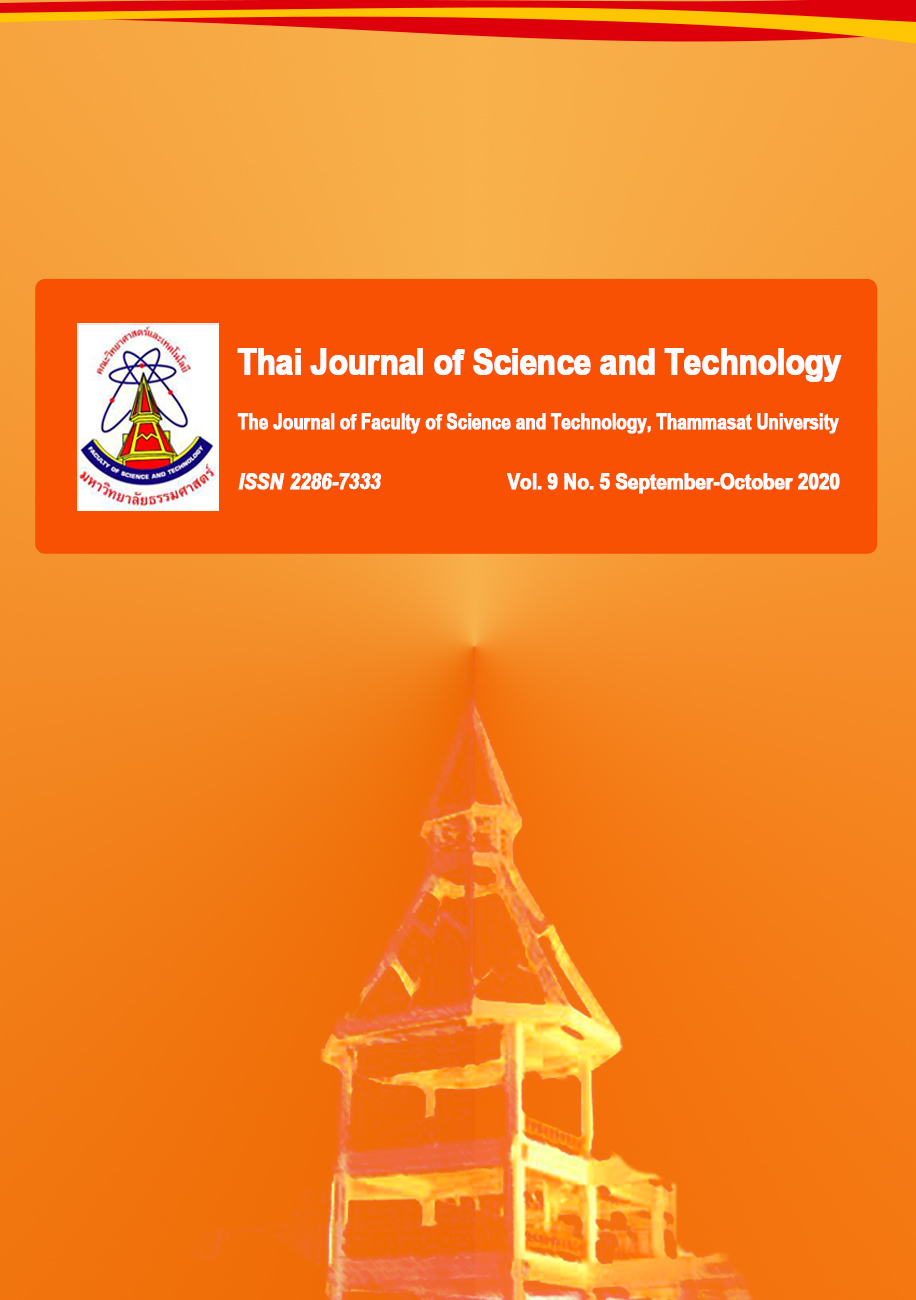ฤทธิ์การต้านอนุมูลอิสระและฤทธิ์การยับยั้งแอลฟากลูโคซิเดสของสารสกัดจากเปลือกอบเชย
Main Article Content
Abstract
This study aimed to examine extraction yield, antioxidant activity, total phenolic content, and alpha-glucosidase inhibitory activity of cinnamon bark extracts for being used as an alternative for type 2 diabetes treatment including diabetic complications alleviation. In this experiment, powdered cinnamon bark was extracted by immersing in 95 % ethanol (EtOH), methanol (MeOH), ethyl acetate (EtOAc), and n-hexane (HEX) under various shaking periods. The results revealed that shaking cinnamon bark with MeOH for 48 h provided the highest extraction yield of 16.75±0.59 %w/w. However, the extracts obtained from shaking with EtOH, MeOH, and EtOAc, possessed approximately the similar high antioxidant activity. In addition, the IC50 values against DPPH radical of the extracts were not statistically different, as the values were found in a range of 2.36 - 5.47 µg/mL. The total phenolic content (TPC) of the ethanolic extracts gained from shaking for 36 and 48 h, expressed the TPC values of 108.53±0.00 and 118.86±2.24 mg GAE/g extract, respectively, while the methanolic extract gained from shaking for 48 h also expressed the TPC value of 116.28±0.00 mg GAE/g extract. Furthermore, the IC50 against alpha-glucosidase of two ethanolic and a methanolic extracts revealed the respective values of 34.82±0.25, 34.43±0.03, and 36.15±0.03 µg/mL, which were highly effective and insignificant differences. One-way analysis of variance also confirmed that the types of extraction solvent and shaking time could affect the extraction yield, antioxidant activity, total phenolic content, and alpha-glucosidase inhibitory activity. The results obviously supported that the 36-h shaken ethanolic extract could be potentially used for alleviating type 2 diabetes.
Article Details
บทความที่ได้รับการตีพิมพ์เป็นลิขสิทธิ์ของคณะวิทยาศาสตร์และเทคโนโลยี มหาวิทยาลัยธรรมศาสตร์ ข้อความที่ปรากฏในแต่ละเรื่องของวารสารเล่มนี้เป็นเพียงความเห็นส่วนตัวของผู้เขียน ไม่มีความเกี่ยวข้องกับคณะวิทยาศาสตร์และเทคโนโลยี หรือคณาจารย์ท่านอื่นในมหาวิทยาลัยธรรมศาสตร์ ผู้เขียนต้องยืนยันว่าความรับผิดชอบต่อทุกข้อความที่นำเสนอไว้ในบทความของตน หากมีข้อผิดพลาดหรือความไม่ถูกต้องใด ๆ
References
Barchan, A., Kali, M.B., Arakrak, A., Pagan, R. and Laglaoui, A., 2014, The effects of solvents polarity on the phenolic contents and antioxidant activity of three Mentha species extracts, Int. J. Curr. Microbiol. Appl. Sci. 3: 399-412.
Colhoun, H.M., Betteridge, D.J., Durrington, P.N., Hitman, G.N., Neil, H.A., Livingstone, S.J., Thomason, M.J., Mackness, M.I., Charlton-Menys, V. and Fuller, J.H., 2004, Primary prevention of cardiovascular disease with atorvastatin in type 2 diabetes in the Collaborative Atorvastatin Diabetes Study (CARDS): Multicentre randomised placebo-controlled trial, Lancet 364: 685-696.
de Melo, E.B., Silveira, G. and Carvalho, I., 2006, α- and β-Glucosidase inhibitors: Chemical structure and biological activity, Tetrahedron 62: 10277-10302.
Guariguata, L., Whiting, D.R., Hambleton, I., Beagley, J., Linnenkamp, U. and Shaw, J.E., 2014, Global estimates of diabetes prevalence for 2013 and projections for 2035, Diabetes Res. Clin. Pract. 103: 137-149.
Loh, S.P. and Hadira, O., 2011, In vitro inhibitory potential of selected Malaysian plants against key enzymes involved in hyperglycemia and hypertension, Malays J. Nutr. 17: 77-86.
Wang, C.C.L., Hess, C.N., Hiatt, W.R. and Goldfine, A.B., 2016, Clinical update: Cardiovascular disease in diabetes mellitus: Atherosclerotic cardiovascular disease and heart failure in type 2 diabetes mellitus, Mechan. Manag. Clin. Considerat. Circulat. 133: 2459-2502.
Marcovecchio, M.L., 2017, Complications of acute and chronic hyperglycemia, US Endocrinol. 13: 1-5.
Maritim, A.C., Sanders, R.A. and Watkins, J.B., 2003, Diabetes, oxidative stress, and antioxidants: A review, J. Biochem. Mol. Toxicol. 17: 24-38.
Mathew, S. and Abraham, T.E., 2006, In vitro antioxidant activity and scavenging effects of Cinnamomum verum leaf extract assayed by different methodologies, Food Chem. Toxicol. 44: 198-206.
Shihabudeen, H.M.S., Priscilla, D.H. and Thirumurugan, K., 2011, Cinnamon extract inhibits α-glucosidase activity and dampens postprandial glucose excursion in diabetic rats, Nutr. Metab. 8: 46-46.
Muhammad, D.R.A. and Dewettinck, A., 2017, Cinnamon and its derivatives as potential ingredient in functional food: A review, Int. J. Food Propert. 20: 2237-2263.
Ritz, C., Baty, F., Streibig, J.C. and Gerhard, D., 2016, Dose-response analysis using R., PLoS One 10(12): e0146021.
Santos, C.M.M., Freitas, M. and Fernandes, E., 2018, A comprehensive review on xanthone derivatives as alpha-glucosidase inhibitors, Eur. J. Med. Chem. 157: 1460-1479.
Tundis, R., Loizzo, M.R. and Menichini, F., 2010, Natural products as alpha-amylase and alpha-glucosidase inhibitors and their hypoglycaemic potential in the treatment of diabetes: an update, Mini. Rev. Med. Chem. 10: 315-331.
Wu, Y., Ding, Y., Tanaka, Y. and Zhang, W., 2014, Risk factors contributing to type 2 diabetes and recent advances in the treatment and prevention, Int. J. Med. Sci. 11: 1185-1200.


